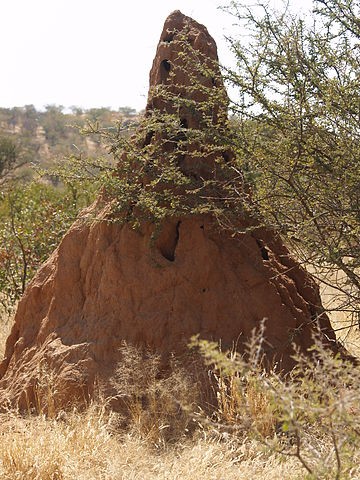Tiny Termites Help in Fighting Climate Change
| Marco Foronda | | Feb 06, 2015 07:20 AM EST |
(Photo : wikipedia.org) Termite mound in Etosha National Park, Namibia.
New research suggests the dirt mounds made by termites could be preventing deserts from spreading into semi-arid ecosystems, making these areas more resilient to climate change.
According to the study, termite mounds often serve as oases of plant life in otherwise dry and desolate regions. This may provide no comfort to homeowners with wood-chomping termites under their houses, but termites turn out to be critical to ecosystems since the mound oases help sustain both big and small wildlife.
Like Us on Facebook
The study used a mathematical model to simulate the changes that take place during desertification and matched the theoretical results with real observations in termite-inhabited regions on the edge of deserts.
Robert Pringle, an ecologist and evolutionary biologist at Princeton and co-author of the paper, said the unexpected effect termites had in protecting against desertification suggest other tunnel-building animals such as ants, prairie dogs and gophers may have a similar role.
He explained that termite mounds store nutrients and moisture, and (through internal tunnels) allow water to better penetrate soil. As a result, vegetation flourishes on and near termite mounds in ecosystems otherwise highly vulnerable to "desertification," meaning the environment's collapse into desert.
"I like to think of termites as the linchpins of the ecosystem in more than one way. They increase the productivity of the system, but they also make it more stable, more resilient," said Professor Pringle.
Termites are "eusocial" insects, meaning they live in colonies of overlapping generations and have a division of labor based on a caste system much like ants and bees. They live off dead and decaying matter and are critical for the re-cycling of soil nutrients, but they can cause havoc to timber homes.
The new study was published in the journal, Science.
Tagstiny termites, Ecosystem, desertification, vegetation, Desert, termites
©2015 Chinatopix All rights reserved. Do not reproduce without permission
EDITOR'S PICKS
-

Did the Trump administration just announce plans for a trade war with ‘hostile’ China and Russia?
-

US Senate passes Taiwan travel bill slammed by China
-

As Yan Sihong’s family grieves, here are other Chinese students who went missing abroad. Some have never been found
-

Beijing blasts Western critics who ‘smear China’ with the term sharp power
-

China Envoy Seeks to Defuse Tensions With U.S. as a Trade War Brews
-

Singapore's Deputy PM Provides Bitcoin Vote of Confidence Amid China's Blanket Bans
-

China warns investors over risks in overseas virtual currency trading
-

Chinese government most trustworthy: survey
-

Kashima Antlers On Course For Back-To-Back Titles
MOST POPULAR
LATEST NEWS
Zhou Yongkang: China's Former Security Chief Sentenced to Life in Prison

China's former Chief of the Ministry of Public Security, Zhou Yongkang, has been given a life sentence after he was found guilty of abusing his office, bribery and deliberately ... Full Article
TRENDING STORY

China Pork Prices Expected to Stabilize As The Supplies Recover

Elephone P9000 Smartphone is now on Sale on Amazon India

There's a Big Chance Cliffhangers Won't Still Be Resolved When Grey's Anatomy Season 13 Returns

Supreme Court Ruled on Samsung vs Apple Dispute for Patent Infringement

Microsoft Surface Pro 5 Rumors and Release Date: What is the Latest?










